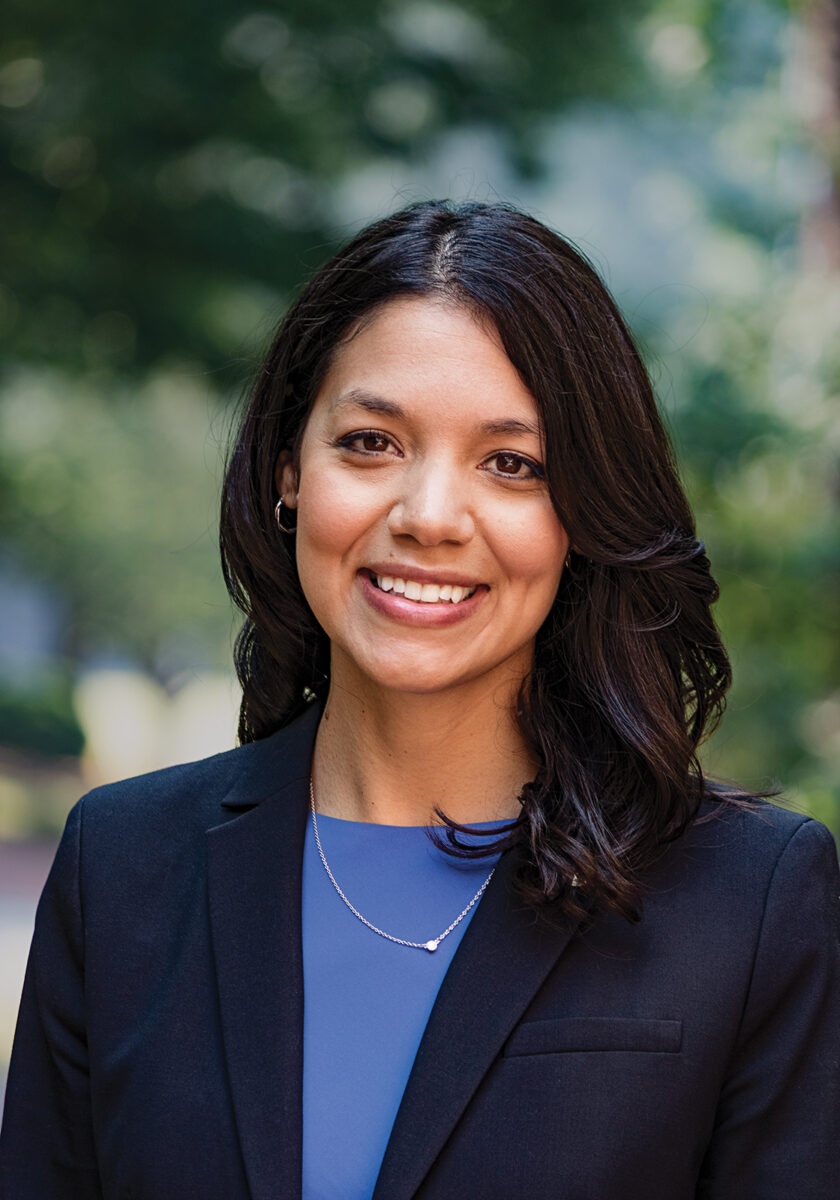Community. Collaboration. Carolina.
Posted on Nov. 16, 2023
Carolina Alumni president Veronica Mora Flaspoehler ’08. Photo: Carolina Alumni/Jason D. Smith ’94
In October, I boarded a bus with 40 faculty members and senior administrators and headed to eastern North Carolina. We were on the Tar Heel Bus Tour, a trip organized by the chancellor’s office for Carolina faculty and administrators to learn about Carolina’s partnerships across the state and hear from North Carolinians about their communities’ needs and how Carolina can help address them. One bus heads to the western part of the state and the other to the eastern region.
We went east, traveling to 10 counties in three days. Our first stop was in Raeford, in Hoke County, where my husband and I lived when he was stationed at Fort Liberty. We stopped at Hoke County High School and were greeted by a marching band, cheerleaders and the junior ROTC, but the energy didn’t stop there. We met Leticia Ledezma ’21, a member of the Carolina College Advising Corps. Ledezma is helping low-income, first-generation and underrepresented students find their way to college. The partnership with Hoke County High School builds trusted relationships with students and exposes them to a range of two- and four-year schools.
Next, we moved on to Pembroke, in Robeson County, where we learned about the history, culture, art and challenges facing the Lumbee Tribe. The tribal seal includes a medicine wheel split into four colors that represent the stages of life, as well as the emotional, mental, physical and spiritual parts of a person. Our Lumbee host said the wheel’s red represents the east because the sun rises in the east. When the sun rises it brings wisdom and knowledge and a new beginning in our lives. Whatever we did today, whether good or bad, ends when the day ends. When the sun rises in the morning, we have a new beginning to be the best that we can be. We learned UNC partners with Robeson County through the Whole Community Connection program, which provides leadership training and funding for local leaders to develop community-led interventions to improve health equity in rural North Carolina.
We then traveled to Whiteville, where Justin Smith ’07, owner and publisher of The News Reporter, founded in 1896, and Les High ’84, who started the Border Belt Independent in 2021, shared their passion for journalism. The News Reporter, with the Tabor-City Tribune, won the Pulitzer Prize for Public Service in 1953 for reporting on Ku Klux Klan activities in Columbus County. In today’s business environment, many local newspapers are not surviving. But there’s hope because of the UNC-Knight Foundation Table Stakes Newsroom Initiative, a Hussman School of Journalism and Media program that provides MBA-like training for journalists in business, organizational change, digital transformation and audience-first practices. Table Stakes has helped news organizations such as The News Reporter respond to the changing media landscape.
The next day we spent our morning in Wrightsville Beach with the N.C. Collaboratory and state Sen. Michael Lee ’91. The Collaboratory partners with academic institutions and state agencies to transform research into practical information state and local governments can use to develop solutions for issues they face in their communities. Since 2018, the Collaboratory, funded by the General Assembly, has supported UNC’s NC Pure Project, which is developing technologies that can remove so-called forever chemicals from drinking water.
Later that day, we were guided on a tour of East Kinston by Kinston city council member Chris Suggs ’21, the youngest elected official in North Carolina. Suggs took us to Lincoln City, a once vibrant community on the southeastern edge of town that was full of businesses, churches and houses and was segregated from the wealthier side of Kinston. In 1999, Hurricane Floyd flooded the community and washed it away. The Federal Emergency Management Agency purchased the land in 2000, but all that’s left are woods and acres of unkempt shrubbery and dirt paths. Suggs founded the nonprofit Kinston Teens and has embarked on initiatives to serve and improve East Kinston.
I was moved to tears at our stop in Fayetteville — not because of my connection to Fort Liberty, but because of the deeply meaningful work Professor John Brooker ’03 and his students at the Military and Veterans Law Clinic are doing to serve low-income former service members who are precluded from receiving Department of Veterans Affairs health care and disability benefits because of their discharge status. These service members were wrongly discharged and have unfairly fallen through the cracks. A client shared how the clinic worked to not only restore his VA benefits, but ensure he was awarded a long overdue Purple Heart from the Army.
We also traveled to Morehead City and learned about UNC’s Institute of Marine Sciences, and then on to Mount Olive, where the Wayne County Public Library leads a collaboration with Carolina Across 100, a pan-university effort to partner with communities in each of North Carolina’s 100 counties and build cross-sector collaborations to address challenges facing communities. We lunched in Goldsboro at Wilber’s Barbecue, owned by Willis Underwood III ’87, his son, Willis IV ’19, Alfred Griffin III ’87 (’97 MBA), Jim Parker ’73 and Jim Kerr II ’92. We stopped in Pittsboro, where Innovate Carolina has partnered with 79°West Innovation Hub to offer entrepreneurial education to Chatham County residents.
The theme throughout the tour was building and empowering communities through collaboration. By leveraging our collective strengths at UNC, we can make, and are making, an incredible impact. By connecting alumni with on-campus faculty and resources, we can advance amazing work happening across so many communities.
To my new friends that went on this journey with me – East is the Beast.
— Veronica Mora Flaspoehler ’08
Thanks for reading the Carolina Alumni Review
Carolina Alumni members, sign in to continue reading.
Not yet a member? Become one today.
